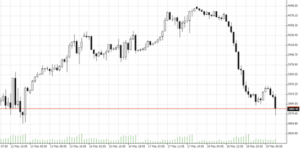

19.05.2022 – So this is what it looks like when inflation hits the stock market: retailers Walmart and Target cut their forecasts. Which triggered a selling frenzy. And if Jerome Powell adds to that with an extremely hawkish statement, then we have a mess.
What a feast for the bears: down 5 percent for the Nasdaq 100. Down 3.6 percent for the Dow Jones, a loss of 4 percent for the S&P 500. Both indexes posted their worst daily percentage loss since June 11, 2020. Is it time for a countermovement now? It doesn’t look like it yet, as evidenced by a look at the hourly chart of the SPX 500.

Source: Bernstein Bank GmbH
First Walmart, then Target – two giants from the U.S. retail sector had triggered the price avalanche, other retailers also came under pressure. The supermarkets felt the significant increase in costs in the first quarter – higher prices for gasoline, rising prices for products, rising wages, reluctance to buy among customers when everything becomes too expensive. Target lost a whopping 25 percent in the meantime – hefty, hefty. The biggest one-day loss since 1987.
Aggressive Fed
And then there was Jerome Powell. Somewhat surprisingly, the stock market took a while to process his clear statement: Already on Tuesday, the Fed chief said the U.S. central bank would tighten the monetary reins until inflation was under control. First, there would have to be clear and convincing signs that upward pressure on prices was easing, he stressed at an event hosted by the Wall Street Journal. A more aggressive approach is certainly possible, he added.
50 steps ahead
He added that if necessary, the Fed would also move beyond the neutral level without hesitation. That neutral level is 25 basis points – then the Fed chief reiterated that further 50-step moves were likely as long as the state of the economy did not fundamentally change. Literally, “If that involves moving past broadly understood levels of neutral we won’t hesitate to do that.” In any case, he said, inflation needs to be brought down much closer to the 2 percent target. There is work to be done: Currently, inflation is at 8.3 percent, the highest level in four decades.
JPMorgan commented, Don’t fight the Fed – it wants weaker growth. A strong dollar, lower stock prices, higher mortgage rates are likely to weaken demand. Gradually, it said, this will lead to falling demand for labor. Nothing to add – Bernstein Bank wishes successful trades and investments!
Important Notes on This Publication:
The content of this publication is for general information purposes only. In this context, it is neither an individual investment recommendation or advice nor an offer to purchase or sell securities or other financial products. The content in question and all the information contained therein do not in any way replace individual investor- or investment-oriented advice. No reliable forecast or indication for the future is possible with respect to any presentation or information on the present or past performance of the relevant underlying assets. All information and data presented in this publication are based on reliable sources. However, Bernstein Bank does not guarantee that the information and data contained in this publication is up-to-date, correct and complete. Securities traded on the financial markets are subject to price fluctuations. A contract for difference (CFD) is also a financial instrument with leverage effect. Against this backdrop, CFD trading involves a high risk up to the point of total loss and may not be suitable for all investors. Therefore, make sure that you have fully understood all the correlating risks. If necessary, ask for independent advice. CFDs are complex instruments and are associated with the high risk of losing money quickly because of the leverage effect. 68% of retail investor accounts lose money trading CFD with this provider. You should consider whether you understand how CFD work and whether you can afford to take the high risk of losing your money.7
